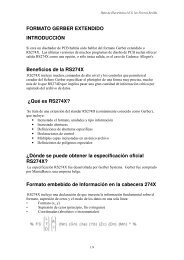Evolución de los Microprocesadores ( INTEL-AMD ) - IES Los Viveros
Evolución de los Microprocesadores ( INTEL-AMD ) - IES Los Viveros
Evolución de los Microprocesadores ( INTEL-AMD ) - IES Los Viveros
You also want an ePaper? Increase the reach of your titles
YUMPU automatically turns print PDFs into web optimized ePapers that Google loves.
<strong>Evolución</strong> <strong>de</strong> <strong>los</strong> <strong>Microprocesadores</strong> (<strong>INTEL</strong> – <strong>AMD</strong>)<br />
Índice<br />
1.- Introducción Pág. 5<br />
2.- Relación entre <strong>los</strong> microprocesadores y las placas<br />
madres<br />
Pág. 6<br />
2.1.- <strong>Los</strong> competidores Pág. 6<br />
2.2.- Pruebas <strong>de</strong>l MMX Pág. 7<br />
2.3.- Que pasa con el Pentium II ? Pág. 8<br />
3.- <strong>Evolución</strong> <strong>de</strong> <strong>los</strong> <strong>Microprocesadores</strong> <strong>de</strong> Intel Pág. 9<br />
3.1.- Microprocesador Intel 4004 Pág. 12<br />
3.2.- Intel (Familia 8051) Pág. 13<br />
3.3.- Microprocesador Intel 8080 Pág. 14<br />
3.4.- <strong>Microprocesadores</strong> 8086/88, 286 y 386 Pág. 14<br />
3.4.1.- Registros <strong>de</strong>l 8086 y <strong>de</strong>l 286 Pág. 17<br />
3.5.- Introducción al microprocesador 80486 Pág. 20<br />
3.5.1.- El microprocesador 80486 Pág. 21<br />
3.5.1.1.- Bloques que componen el 80486 Pág. 21<br />
3.5.1.2.- Diagrama <strong>de</strong> base <strong>de</strong> <strong>los</strong> microprocesadores<br />
80486DX y 80486SX<br />
Pág. 22<br />
3.5.1.3.- Definiciones <strong>de</strong> las terminales Pág. 22<br />
3.5.1.4.- Arquitectura básica <strong>de</strong>l 80486 Pág. 26<br />
3.5.1.5.- Sistema <strong>de</strong> memoria <strong>de</strong>l i80486 Pág. 28<br />
3.5.1.5.1.- Verificador/Generador <strong>de</strong> paridad Pág. 28<br />
3.5.1.5.2.- Temporización <strong>de</strong> la lectura <strong>de</strong> memoria Pág. 29<br />
3.5.1.5.3.- Adquisición <strong>de</strong> memoria <strong>de</strong>l 80486 Pág. 30<br />
3.5.1.6.- Unidad <strong>de</strong> cache Pág. 30<br />
3.5.1.6.1.- Funcionamiento Pág. 31<br />
3.5.1.7.- Versiones <strong>de</strong>l 80486 Pág. 32<br />
3.5.1.8.- Nuevas instrucciones <strong>de</strong>l 80486 Pág. 33<br />
3.5.1.9.- ¿ Cuál es la diferencia entre el 486DX2 y el<br />
486DX4 ?<br />
Pág. 33<br />
3.6.- Introducción al microprocesador Pentium Pág. 34<br />
3.6.1.- Vías <strong>de</strong> acceso múltiples Pág. 35<br />
3.6.2.- Depen<strong>de</strong>ncias <strong>de</strong> procedimientos Pág. 37<br />
3.6.3.- Ejecución <strong>de</strong> punto flotante en el Pentium Pág. 38<br />
3.6.4.- Ahorro <strong>de</strong> energía Pág. 38<br />
3.6.5.- Nuevas<br />
Pentium<br />
instrucciones <strong>de</strong>l microprocesador Pág. 39<br />
3.7.- <strong>Microprocesadores</strong> Pentium con tecnología MMX Pág. 40<br />
3.8.- Introducción al microprocesador Pentium II Pág. 44<br />
3.8.1.- El microprocesador Pentium II Pág. 44<br />
3.8.1.1.- Características Pág. 45<br />
3.8.1.2.- Características técnicas Pág. 45<br />
3.8.2.- El nuevo SLOT ONE Pág. 46







